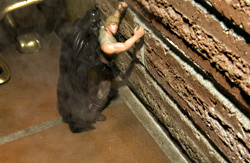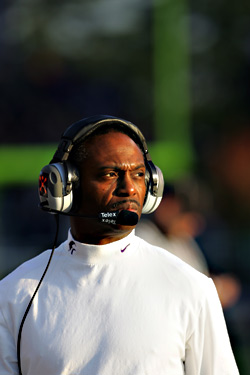Bob Pearson is a hooter. More by obsession than employment, hooters tramp through the woods of the Northwest each spring and summer calling for owls. They are part of an effort to gauge how many northern spotted owls—the almost-mythic raptor that forever changed logging in the Northwest a decade ago—still live among the Douglas fir and cedars.
What the hooters have found is that the spotted owl population is crashing despite more than a decade of work to set aside large blocks of forest habitat for them. Especially in Washington, the population of the football-sized owl is down as much as 50 percent in 10 years. That’s according to population surveys by biologists working for the federal government and by hooters like Pearson, who conduct their own counts in between occasional surveys under contract for the feds.
The government has designated the owl as a “threatened” species.
“Why is it only ‘threatened’?” asks Kent Livezey, a supervisory wildlife biologist with the U.S. Fish and Wildlife Service. “It should be endangered.” Livezey has collaborated with Pearson on survey work in the Gifford Pinchot National Forest in southwestern Washington.
A decade ago, the Fish and Wildlife Service said that a decrease of 50 percent would be a worst-case scenario, according to federal documents. “I think, if anything, the spotted owl right now is more threatened than it was in the 1970s and early 1980s, when we were cutting trees like crazy,” says Eric Forsman, a wildlife biologist with the U.S. Forest Service’s Pacific Northwest Research Station in Corvallis, Ore.
The threat to the owl keeps Pearson out in the mountains tracking the birds, as he has for 10 years. He can hike and smoke cigarettes and hoot—”Wu wuwuwu wu!”— almost simultaneously. On a summer afternoon in the Gifford Pinchot National Forest, he’s in such a sweat looking for owls that there’s a sheen across his forehead and rivulets running down his neck. Searching for wild animals is often hard, hit-and-miss work. Not so with the spotted owl.
A male spotted owl appears just below a logging road and stares at Pearson. Unlike most other wild animals, spotted owls present themselves for inspection quite willingly. You can crunch across the forest floor and draw within 10 feet of an owl — face to face with the symbol of struggle between the Northwest’s old timber economy and culture and environmentalism. He doesn’t fly away.
“You don’t just get these furtive glimpses of it,” says Pearson, who regularly monitors known owl sites on his own time and own dime. The federal government has largely pulled back from performing extensive owl surveys.
As crucial as Pearson’s work is to filling that data void, it’s a long way from affecting policy, even though forest policy is again big news in the Northwest. The Bush administration says it wants to increase logging in national forests in the region, and environmentalists are outraged. The debate will begin in earnest in Congress this week.
FOR MUCH OF the late 1980s and early 1990s, environmentalists feared the owl would become extinct as the last of the great Northwest forests were turned into two-by-fours. The spotted owl can’t live in just any forest. It prefers to eat flying squirrels, and flying squirrels prefer the high canopy of old growth. Environmental groups sued the government, and, at one point, U.S. District Judge William Dwyer halted logging on federal land. That legal battle gave rise to President Clinton’s 1994 Northwest Forest Plan, which was supposed to protect owl habitat while allowing logging to continue.
With that compromise established, the environmental community stopped obsessing about the owl. For its part, the federal government stopped most of its owl surveys.
But Pearson never stopped worrying. For the past 10 years, he’s faithfully monitored spotted owl sites on the north side of the Gifford Pinchot National Forest. Owls typically nest in the same spot for much of their average 15-year life span, so cataloging them from year to year can sometimes be a simple matter. He drives along logging roads, leaning out the window, and hooting one of the 14 owl calls he’s mastered.
Pearson has found recently that often the owls aren’t hooting back, despite repeated visits to the sites. In a recent count, as many as 40 of 139 owl sites were unoccupied. Pearson hears a quiet forest and, increasingly, the call of another owl, the barred owl. Barred owls, which have migrated from the eastern United States over the past century, are more aggressive than spotted owls and have begun to compete for territory and food.
It’s not as if the spotted owls have simply moved elsewhere; Pearson has been unable to find new spotted owl sites. The owls seem to have disappeared. Pearson and Livezey blame the barred owl incursion for the disappearance of the spotted owl.
Wildlife biologists report similar findings throughout Washington. Dale Herter, a biological consultant for the U.S. Forest Service and private timber companies, says spotted owl populations have dropped by 50 percent over the past 10 years in a portion of the Mount Baker- Snoqualmie National Forest that he monitors. Stan Sovern, a wildlife biologist with the Forest Service’s Pacific Northwest Research Station in Cle Elum, has seen a 53 percent decline over the past decade in the Okanogan-Wenatchee National Forest.
Both attribute much of the loss to barred owls and some habitat loss due to logging.
In Olympic National Park, one of the most pristine and protected environments for spotted owls in the Northwest, their population has dropped by 44 percent, according to Don Smith, who supervises field studies for the National Park Service. That’s far more than the 1 percent a year decline the government forecast in the early 1990s. A broader study of forests on the Olympic Peninsula pegs the decrease at more than 12 percent a year.
Wildlife biologists aren’t full of answers for how to approach the problem.
“We have to keep asking ourselves, is there anything we can do to favor the spotted owl over the barred owl?” says Livezey. At this point, he says, it is too early to say.
Says Herter: “There’s not much to say, except we may have to say goodbye to them.”
The timber industry has a different view of the spotted owl’s status. It believes that the spotted owl is in good enough shape that it ought to be removed from the threatened-species list, says Chris West, a vice president at the American Forest Resources Council, an industry trade group. That could ease logging restrictions in the Northwest.
In April, the council sued the Fish and Wildlife Service, claiming that the agency hadn’t updated owl studies every five years as required by law. “I’m not sure they are going to like the answer,” says the agency’s Livezey. Industry biologists didn’t return calls seeking a scientific explanation for why the owl could be delisted.
Bob Pearson, for one, thinks the timber industry is off base.
“We’re just looking for a balance over the last 10 percent of land that’s available to them,” he says, referring to the amount of unlogged old-growth forest remaining in the Northwest. “So I have very little sympathy for the timber industry.”








